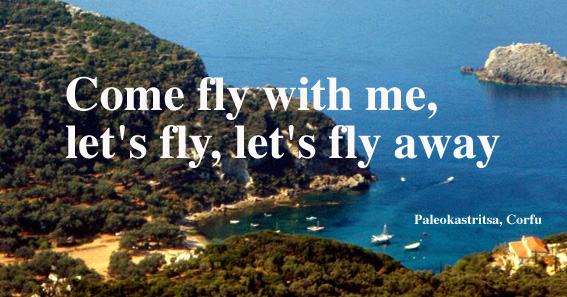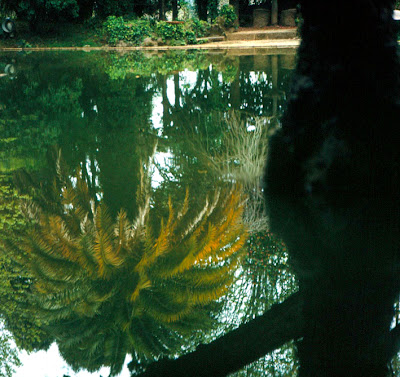A Garden in Portugal
Years ago, this place must have echoed with laughter and music, as ladies and gentlemen, in silks and feathers, watched entertainments on the lake, sipping champagne as the moon rose high overhead
Years ago, this place must have echoed with laughter and music, as ladies and gentlemen, in silks and feathers, watched entertainments on the lake, sipping champagne as the moon rose high overhead
 One of the world's most extraordinary gardens is hidden away in a small Portuguese town, away from the eyes of tourists, largely ignored by the locals, unmentioned by the travel books and brochures. It is a splendid secret, this garden. Unless you happen upon it by chance, as I did, you're sure to pass it by - and, by so doing, miss out on a fin de siecle dream. As far as I could tell, the garden didn't even have a name.
One of the world's most extraordinary gardens is hidden away in a small Portuguese town, away from the eyes of tourists, largely ignored by the locals, unmentioned by the travel books and brochures. It is a splendid secret, this garden. Unless you happen upon it by chance, as I did, you're sure to pass it by - and, by so doing, miss out on a fin de siecle dream. As far as I could tell, the garden didn't even have a name.I discovered the garden after visiting the old castle which adjoins it. I had been sightseeing up and down the coast and was staying a few days in Espinho, a well-known watering hole before the Great War but today a trifle down-at-heel, despite its spanking new hotel and casino. Before I moved to the hotel that overlooks the Atlantic, I stayed in a pink stucco mansion that ultimately left a lot to be desired. The landlady was a large siren called Rosita, who swept through the boarding house like a ship in full sail. It was Rosita who insisted I visit the castle at Vila de Feira. "Very close, very close" she said, and it was, too. By car, along back roads sweet with flowering eucalyptus, just twenty minutes. By local train (from Oporto via Espinho) a few minutes more.
The castle of Vila de Feira (population 4,000) is mentioned in the guidebooks, and for good reason. It's an impressive fortification built with massive blocks of blue-gray stone. Its square keep and four squat towers dominate the landscape. A caretaker, who lives in a tiny white house built onto the castle wall, will give you a wide, toothless smile and let you in for the equivalent of a few cents; once inside, he'll leave you to your own devices so you can explore the place with the shadows and the echoes of the centuries to accompany you.
The castle isn't large. Built in the 11th century, it was reconstructed four hundred years later by the local baron. Grey and mossy, the castle has slits in its outer perimeter for defensive bowmen; today, these slits make excellent peep-holes, especially when the fruit trees in the secret garden next door are bright with blossom. When you enter, under the baronial coat of arms, you walk up a worn stone staircase (watch your head) to a superb Gothic hall, where the baron and his cronies must have sat around the huge fireplace, watching flames curl around a roasting calf. This hall is very evocative; half close your eyes and you can see the smoke from the fire, the guttering candles on long oaken tables and the minstrels playing in the gallery above.
Up on top, as you stroll by the towers, watch out for round holes cut out of the stone floor - with nothing beneath but the grassy slope, far below. This curious architectural touch had a very practical purpose; these are, in fact, the castle's toilet facilities, efficient but unpleasant for an unsuspecting soul walking below. One such hole is protected from prying eyes by a stone wall. Perhaps it was for the baron's exclusive use. We'll never know.
I explored the castle and then, leaving it, I saw ornate iron gates and walked through them into the garden. The garden surrounds a large white villa and spills, green and lush, down the hillside. When I was there, the villa appeared to be deserted, save for a gardener raking leaves and a little girl, perched on a bench, eating an orange. There was no other sign of life. It's possible that this was once a private residence. No more, however. The visitor is not barred today and this hillside in Vila de Feira is a magic place, green and shaded, with hints of elegance and decadence of an era long since gone.
The most surprising part of the garden lies halfway down the hill, hidden away until you almost fall into it. And, suddenly, there it is: an artificial lake the colour of a lime popsicle, a fanciful bridge to span it and the piece de resistance - a great grotto carved into the hillside. The lake mirrors both garden and the bridge; the latter appears, at first glance, to be made of logs and branches and twigs, but closer inspection reveals life-like moulding in cement, sinuous and a trifle bizarre. Its artificiality contrasts oddly but interestingly with the palms and the shrubbery of the surrounding garden.
The bridge leads your eye to the grotto, a huge baroque creation in cement, a giant hand, fingers arched, clutching at the hill. Inside the grotto, in a mysterious twilight accented by splashes of reflected sunlight, you can view the lake and its reflections from two levels. The grotto encircles you, its folds and drapes like a theatre curtain half drawn up to frame your view. Years ago, this place must have echoed with laughter and music, as ladies and gentlemen, in silks and feathers, watched entertainments on the lake, sipping champagne as the moon rose high overhead. It has to be seen; no words (or pictures) can do justice to its seductive charm. It is a triumph of artifice, an artnouveau creation that compares favourably with a design by Gaudi or a piece of Tiffany glass.
Portugal has endless delights and, despite rising prices, it's still a traveller's bargain; accommodation costs less, the famed seafood costs more than it once did but you'll still be able to afford it, the fado clubs can still be found in the larger towns and cities, places where you can sit and sip and listen to some of the world's most passionately melancholic folk music.
And then, of course, there's Portugal's secret garden. With its dragon flies and roses, it waits for you now. Once seen, it will stay with you forever.









